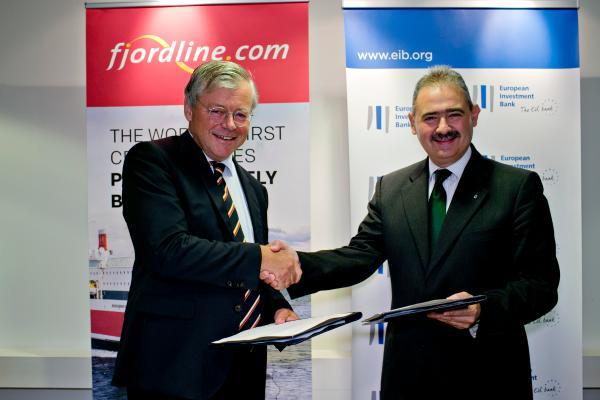
The European Investment Bank (EIB) is providing a EUR 124 million loan to the shipping company Fjord Line for the expansion of its fleet. Two new LNG cruise ferries are operating between Bergen, Stavanger, Langesund (Norway) and Hirtshals (Denmark). The ferries – MS “Stavangerfjord” and MS “Bergensfjord” – were delivered by the Norwegian shipbuilder Bergen Group in 2013 and earlier this year.
Thanks to this investment backed by the bank of the European Union, each of the new vessels offers daily services for up to 1 500 passengers and 600 vehicles. They have been constructed to the highest international and European environmental standards and are equipped with LNG-fuelled engines. The application of clean technology will significantly reduce emissions harmful to the environment from ships. The reduction of CO2 emissions can reach as high as 23% in comparison with the use of standard marine engines powered by heavy fuel oil.
Mihai Tănăsescu, EIB Vice-President responsible for lending in Norway, said: “The EIB strongly supports the development of sustainable European transport. We therefore particularly welcome this agreement with Fjord Line, as the new vessels fuelled by LNG have improved the overall environmental performance of the company’s fleet. As they have also increased the capacity deployed on the routes between Norway and Denmark, this investment will contribute to the EU policy of promoting short sea shipping – a transport mode which is highly efficient not only in terms of environmental performance but also as regards energy efficiency.”
Peter Frølich, Chairman of the Board of Fjord Line said: "The EIB’s involvement is recognition of Fjord Line's commitment to sustainable sea transportation between Norway and the EU. We are proud to be the first Norwegian maritime transport company to have signed a loan agreement with the European Investment Bank. The loan assures us long-term financial resources at a lower cost, thus providing financial value added for Fjord Line. The loan has been secured by a guarantee from the Kingdom of Norway, through the state support credit agency GIEK," he added. “Considering that Norwegian maritime traditions go all the way back to the Viking age, it seemed only right to have a heavy Norwegian presence in the design and construction of the ships, which was done by Bergen Group Fosen with many Norwegian contributors and suppliers. The beauty of these ships is much more than skin deep. They are built to shrug off the often-harsh conditions of the North Sea.”
Øyvind Ajer, Assistant Director General of GIEK said: "GIEK supports Norwegian exporters with guarantees for their buyers’ financing. The guarantees have supported the Norwegian maritime sector in developing environmentally friendly technology, and the Fjord Line ferries are a good example of this. The loan to Fjord Line represents the first guarantee arrangement concluded between GIEK and EIB, and may pave way for other similar financings within the scope of the EIB."
Fjord Line's new cruise ferries are both 170 metres long and have deadweight of 3,900 tonnes. Each ship has 306 cabins.
Both cruise ferries have four liquid natural gas (LNG) powered engines with 12 cylinders that produce 5,400 kW (7,300 hp) of power. Fjord Line's choice of the most advanced engine technology available gives the new ships a propulsion system that is both the most profitable and environmentally friendly. In 2015, new and stricter standards for the sulphur content of ships’ fuel will enter into force in northern Europe. The LNG engines allow Fjord Line to meet these standards with a large margin. When moored, the ship uses auxiliary engines that run on diesel. However, these engines are fitted with powerful catalytic converters that reduce NOx emissions to about the level of the LNG engines.

Photographer: EIB ©To be defined
Download original

Photographer: EIB ©To be defined
Download original

Photographer: EIB ©To be defined
Download original

Photographer: EIB ©To be defined
Download original

Photographer: EIB ©To be defined
Download original

Photographer: EIB ©To be defined
Download original

Photographer: EIB ©To be defined
Download original

Photographer: EIB ©To be defined
Download original

Photographer: EIB ©To be defined
Download original

Photographer: Espen Gees ©Fjord Line
Download original

Photographer: Espen Gees ©Fjord Line
Download original

Photographer: Espen Gees ©Fjord Line
Download original

Photographer: Espen Gees ©Fjord Line
Download original

Photographer: Espen Gees ©Fjord Line
Download original

Photographer: Espen Gees ©Fjord Line
Download original

Photographer: Espen Gees ©Fjord Line
Download original